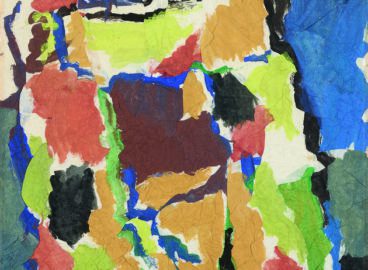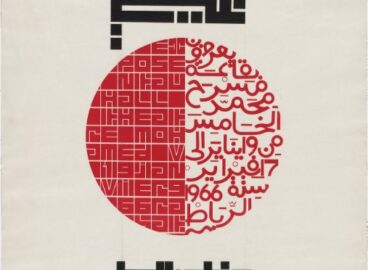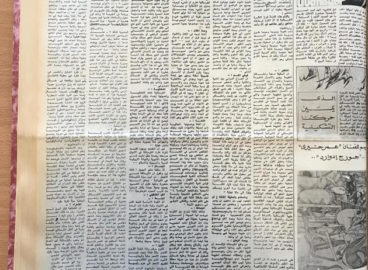The publication, Modern Art in the Arab World: Primary Documents (2018), edited by Anneka Lenssen, Sarah Rogers, and Nada Shabout, offers an unprecedented resource for the study of modernism: a compendium of critical art writings by twentieth-century Arab intellectuals and artists. The selection of texts—many of which appear for the first time in English—includes manifestos, essays, transcripts of roundtable discussions, diary entries, letters, and the guest-book comments including those featured here. Traversing empires and nation-states, diasporas and speculative cultural and political federations, the book’s documents bring light to the formation of a global modernism, through debates on originality, public space, spiritualism and art, postcolonial exhibition politics, and Arab nationalism, among many other topics. The collection is framed chronologically, and includes contextualizing commentaries to assist readers in navigating its broad geographic and historical scope. Interspersed throughout the volume are sixteen contemporary essays: writings by scholars on key terms and events as well as personal reflections by modern artists who were themselves active in the histories under consideration. A newly commissioned essay by historian and Arab-studies scholar Ussama Makdisi provides a historical overview of the region’s intertwined political and cultural developments during the twentieth century.

“I have seen a vibrant genius and an innovative Arab sensibility”: Visitors’ impressions of the 1933 Palestine Pavilion at the First National Arab Fair
Date 1933
Language Arabic, French, English
The texts below are entries taken from the 1933 guest book from the first solo exhibition of the work of Zulfa al-Sa‘di (1905–1988), a young Palestinian female artist, held in the Palestine Pavilion at the First National Arab Fair, organized in Jerusalem under the auspices of the Supreme Muslim Council. Al-Sa‘di, who had studied with the renowned “Jerusalem School” icon painter Nicola Saig (1863-1942), exhibited a range of work: oil paintings of landscapes, still life compositions, and portraits of Arab heroes as well as contemporary cultural and political figures—the latter, such as King Faysal I of Iraq, which is illustrated here, drew on the photographic sources then circulating in the expanding print media—alongside applied arts such as embroidery works.
Hundreds of visitors signed the guest book, many of them identifying hometowns and origins from across the Arab East. Entries are predominantly in Arabic, but also in French and English. The remarks offer a window into a moment when even the format of the solo art exhibition held a kind of modern novelty, demonstrating visitors’ searches for appropriate vocabularies to articulate their responses to al-Sa‘di’s work as well as a common impulse to express national pride.
Guest book entries for Zulfa al-Sa‘di (1933)
The fine arts leave a fine impression on the soul, and the work I’ve seen here has left a deep impression on my soul. I can’t help but rejoice for Miss Zulfa, for this work has amazed me and my companions.
From Gaza, July 22, 1933
Have you heard the lovely melodies? Have you experienced how they make you quiver in delight and arouse sweet hopes and desires in you? This is how a person feels when he sees the refined lady Zulfa al-Sa‘di. The wonderful handicrafts on display in the Arab exhibition stir up great hope in the spectator—the hope that our women are on their way to a renaissance through such beneficial work. This brings us pride and joy.
Tanious Naser, newspaper owner, 1st day of the month of Rabi‘ II, 1352 [July 24, 1933]
We should have great admiration for the skillful hand that produced everything we saw in the first Arab exhibition—the hand of Miss Zulfa al-Sa‘di, who truly counts as one of the treasures of the artistic renaissance in Arab Palestine. We plead to God for more women like Miss Zulfa, so that the men of this nation can come together to revive the glory and civilization that has been wiped out. God bless.
Abd al-Ghani al-Karmi and Muhammad Taha, 1st day of the month of Rabi‘ II, 1352 [July 24, 1933]
I am very proud of the artisanal renaissance that is being carried out by young Arab women in Palestine. I was delighted by the work I saw during my visit to the Arab exhibition, which demonstrates Miss Zulfa al-Sa‘di’s excellent taste. Hopefully the young women of the future will follow in her footsteps. Bravo, Miss al-Sa‘di, and cheers to her work and to all who follow her example—onward until we acquire independence.
Abu Khaldoun, Tulkarem, July 26, 1933
Art expresses the purity and delicateness of the soul and the refinement of morals and excellence. The wonders of Miss Zulfa’s art are a source of pride for Arab handicrafts. She deserves our appreciation, and we commend the precision of her art and wish her brilliant success in her quest.
Omar al Saleh, lawyer, July 27, 1933
The works I found here in this room are truly the best I’ve seen in this blessed Arab exhibition, which is a good start for Arabs in general. The fair hands that worked at night to create these things are a testament to the Arab renaissance of the future. The hands of Miss Zulfa al-Sa‘di will be the best means of spreading the Arab renaissance in the future. Good luck.
[Name illegible], July 27, 1933
I have seen a vibrant genius and an innovative Arab sensibility in Miss Zulfa al-Sa‘di’s exhibited handicrafts. These works demonstrate precision and creativity. May God grant her success—I hope one day she becomes the director of an artisanal school for women, so that future young Arab women can benefit from her singular genius and her innovative taste. Many thanks to her.
Abd al-Raziq Mayri, Aleppo, Syria, July 27, 1933
Zulfa is a wellspring of verse and oratory, for poetry is nothing but tireless effort. Take a look at your creations, Zulfa: they’re marvels, the best on display at the Arab exhibition. The creation of Zulfa, is there wonder in magic? For the magic it contained, bewitched those who beheld it.
Yes, this is truly magic, and a wonder—or rather, many wonders: such extreme precision in the embroidery, such marvelous mastery in the craftsmanship, and such superb representation in the paintings, beyond even the skill of professional painters. When I saw her miraculous paintings, and in particular the one of the cactus fruit, I couldn’t help but try to grab one of the fruits and eat it!
This genius, this lady’s brilliance, is something every Arab can be proud of. It is fair to say that Miss Zulfa’s works are innovations to which nothing can be added—one is left speechless, for such creativity is unprecedented.
Al-Afghani, July 29, 1933
I visited the Arab exhibition, and the truth is that I couldn’t find anything that demonstrates more genius and artistic taste than Ms. Zulfa al-Sa‘di’s handicrafts, oil paintings, and other works. I am truly proud that someone in my dear country has achieved such status in the world of art, for I am but one of that country’s servants.
Akram Abd al-Salam al-Husseini, Ahmad al-Farjouli [?] Raouf Darwish [?], Adnan [illegible], Jerusalem
—From the guest book of Zulfa al-Sa’di’s 1933 exhibition, accessed from the research files of Rhonda Saad, departed colleague of the editors of Modern Art in the Arab World: Primary Documents, who was preparing a study of Palestinian art and its publics until her unexpected death in 2010. Translations from Arabic to English by Kareem James Abu-Zeid


